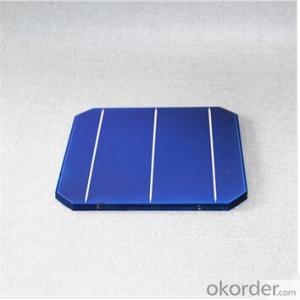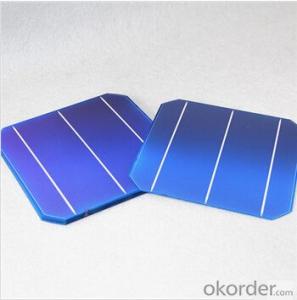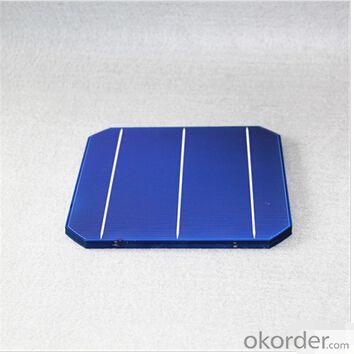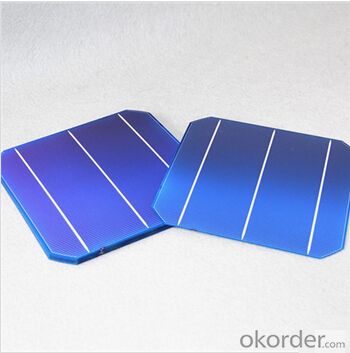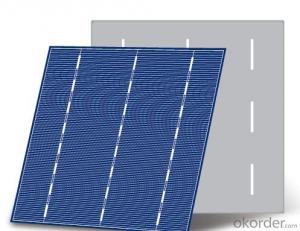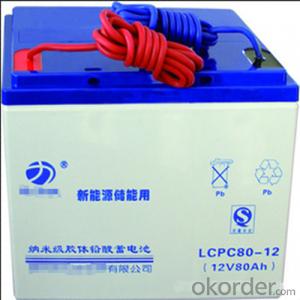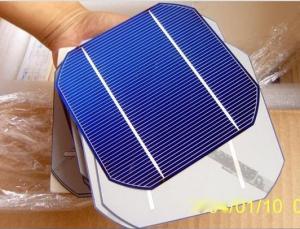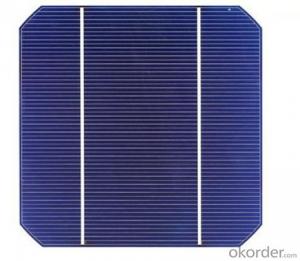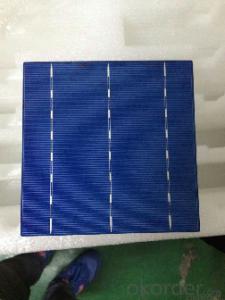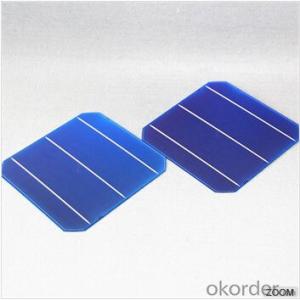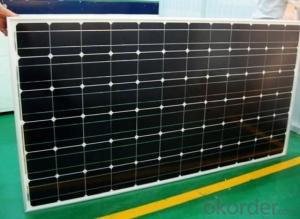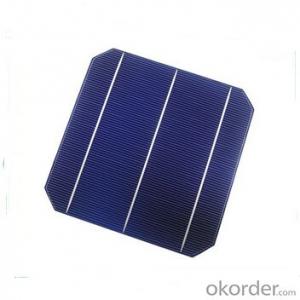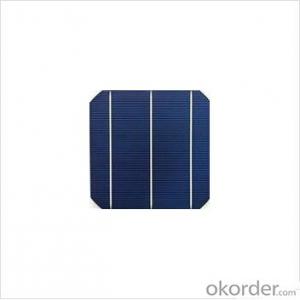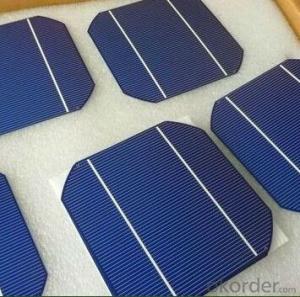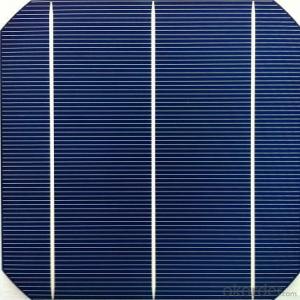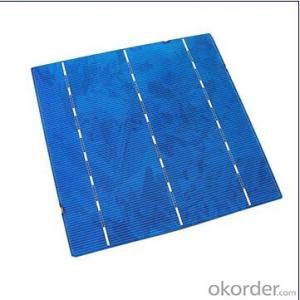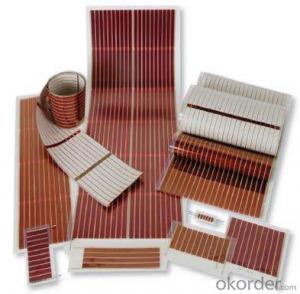High Quality Supply Monocrystalline Drilling Solar Cells
- Loading Port:
- Shanghai
- Payment Terms:
- TT or LC
- Min Order Qty:
- 1000 pc
- Supply Capability:
- 1000000 pc/month
OKorder Service Pledge
OKorder Financial Service
You Might Also Like
Solar Cells:
solar cells, when struck by photons of light from the sun, generates an electrical current which can then be used to power DC or AC electrical loads.
A solar cell is made of silicon. Computer chips are made of this same material. Basically, when light strikes the surface of a solar cell some of it is absorbed into the silicon. This light energy bumps the electrons loose and causes energy to flow
Solar cells is made by solar wafer, it has three categories of solar cell right now, monocrystalline polycrystalline and thin film,These cells are entirely based around the concept of PN junction, which is the critical part of solar module, it is the part that can convert the light energy into electricity, the thickness is from 180um to 200um, with even busbars to conduct electricity, textured cell can decrease diffuse reflection; they are often electrically connected and encapsulated as a module. Photovoltaic modules often have a sheet of glass on the front (sun up) side, allowing light to pass while protecting semiconductor wafers from abrasion and impact due to wind-driven debris, rain, hail, etc. Solar cells are also usually connected in series in modules, creating an additive voltage. Connecting cells in parallel will yield a higher current;With high quality and stable quality. Our Cells can greatly improve the performance of Solar Modules.
Features:
High efficiencies up to 16.4%
Proven long term mechanical stability of silicone
Make of highly purified poly silicone
Three bus bars for reduced series resistance and improved module and cell efficiency
Blue anti-reflecting coating ensures improved light absorption and increased efficiency
Acid texturization offers a uniform appearance and virtually invisible crystal structure
Excellent low light behavior for improved energy yield
Specifications
Efficiency code | Efficiency(%) | Pmax(w) | Impp(A) | Vmpp(V) | Isc(A) | Voc(C) |
196 | ≥19.6 | 4.68 | 8.56 | 0.547 | 8.99 | 0.643 |
194 | 19.4-19.6 | 4.64 | 8.51 | 0.545 | 8.96 | 0.641 |
192 | 19.2-19.4 | 4.59 | 8.46 | 0.542 | 8.93 | 0.639 |
190 | 19.0-19.2 | 4.54 | 8.42 | 0.539 | 8.90 | 0.637 |
188 | 18.8-19.0 | 4.49 | 8.35 | 0.538 | 8.86 | 0.635 |
186 | 18.6-18.80 | 4.44 | 8.33 | 0.533 | 8.84 | 0.631 |
Solar Cells Advantage:
1. High efficiency and High power.
2. Long-term electrical stability.
3. Lowest price and Fastest delivery.
4. Good quality and good service.
5.Bulk supply
6. Good Warranty
7.Big Sale
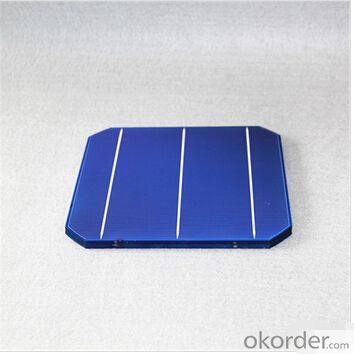
FAQ
We have organized several common questions for our clients,may help you sincerely:
1, What’s price per product ?
A: It’s depends on the quantity, delivery date and payment terms of the order. We can talk further about the detail price issue. Our products is high quality with lower price level.
2, How to make payment?
We accept T/T or L/C.
3, What is your lead time?
Generally 1-5 weeks depends on the order quantity and your specific requirements.
4, Can you do OEM for us?
Yes, we can.
5, How do you pack your products?
We have rich experience on how to pack the panels to make sure the safety on shipment when it arrives at the destination.
Applications of solar cell
A solar cell is an electrical device that converts the energy of light directly into electricity by the photovoltaic effect, which is a physical and chemical phenomenon.[2] It is a form of photoelectric cell, defined as a device whose electrical characteristics, such as current, voltage, or resistance, vary when exposed to light. Solar cells are the building blocks of photovoltaic modules, otherwise known as solar panels.
Solar pv Modules: the application of solar cell
A PV module consists of many PV cells wired in parallel to increase current and in series to produce a higher voltage. 36 cell modules are the industry standard for large power production.
The module is encapsulated with tempered glass (or some other transparent material) on the front surface, and with a protective and waterproof material on the back surface. The edges are sealed for weatherproofing, and there is often an aluminum frame holding everything together in a mountable unit. In the back of the module there is a junction box, or wire leads, providing electrical connections.
There are currently four commercial production technologies for PV Modules:
Single Crystalline
This is the oldest and more expensive production technique, but it's also the most efficient sunlight conversion technology available. Module efficiency averages about 10% to 12%*
Polycrystalline or Multicrystalline
This has a slightly lower conversion efficiency compared to single crystalline but manufacturing costs are also lower. Module efficiency averages about 10% to 11%*
String Ribbon
This is a refinement of polycrystalline production, there is less work in production so costs are even lower. Module efficiency averages 7% to 8%*
Amorphous or Thin Film
Silicon material is vaporized and deposited on glass or stainless steel. The cost is lower than any other method. Module efficiency averages 5% to 7%*
Solar Panels: the application of solar cells
Solar Photovoltaic panels constitute the solar array of a photovoltaic system that generates and supplies solar electricity in commercial and residential applications. Each module is rated by its DC output power under standard test conditions, and typically ranges from 100 to 365 watts. The efficiency of a module determines the area of a module given the same rated output – an 8% efficient 230 watt module will have twice the area of a 16% efficient 230 watt module. There are a few solar panels available that are exceeding 19% efficiency. A single solar module can produce only a limited amount of power; most installations contain multiple modules. A photovoltaic system typically includes a panel or an array of solar modules, a solar inverter, and sometimes a battery and/or solar tracker and interconnection wiring.
- Q: How do solar cells perform in areas with high levels of vibration?
- Solar cells generally perform well in areas with high levels of vibration. The cells are designed to be sturdy and resistant to vibrations, ensuring their longevity and efficiency. However, it is essential to ensure proper installation and maintenance to minimize any potential damage or displacement caused by excessive vibrations.
- Q: What is the impact of solar cells on reducing noise pollution from power generation?
- Solar cells have a minimal impact on reducing noise pollution from power generation since they operate silently, unlike traditional power plants that emit noise during operation.
- Q: What is the role of solar cells in powering agricultural irrigation?
- The role of solar cells in powering agricultural irrigation is to harness the energy from the sun and convert it into electricity. This renewable energy source is used to operate irrigation systems, providing power for pumps and other equipment required for efficient water distribution to crops. Solar cells offer a sustainable and cost-effective solution, reducing reliance on fossil fuels and minimizing the environmental footprint of irrigation practices in agriculture.
- Q: Can anybody tell me how to make a solar cell at home?
- First of all, you need to be sure what you want to do with the solar cell. Do you want to generate electricity or hot water?
- Q: Can solar cells be used in electric fence systems?
- Yes, solar cells can be used in electric fence systems. Solar cells can generate electricity from sunlight and convert it into usable energy, which can power an electric fence system. This eliminates the need for traditional grid power or batteries, making it a cost-effective and environmentally friendly option.
- Q: Can solar cells be used for powering military bases?
- Yes, solar cells can definitely be used for powering military bases. Solar energy is a reliable and sustainable source of power that can provide electricity to meet the energy demands of military facilities. By utilizing solar cells, military bases can reduce their dependency on fossil fuels, enhance energy efficiency, and contribute to a cleaner and greener environment. Additionally, solar power systems can be installed in remote or off-grid locations, making it an ideal solution for powering military bases in various terrains and regions.
- Q: Can solar cells be used in drones?
- Yes, solar cells can be used in drones. In fact, many drones are equipped with solar panels to harness solar energy and power their operations. This helps to extend flight time, reduce reliance on traditional batteries, and make drones more sustainable and energy-efficient.
- Q: How do solar cells compare to other renewable energy sources?
- Solar cells have several advantages over other renewable energy sources. Firstly, solar energy is abundant and widely available, making it a more accessible option for many regions. Additionally, solar cells have a relatively long lifespan and require minimal maintenance, making them a cost-effective choice in the long run. Furthermore, solar energy is a clean and environmentally friendly source, as it produces no harmful emissions or pollutants. However, solar cells do have limitations, such as being dependent on sunlight availability and requiring large surface areas for installation. Overall, solar cells offer a promising and efficient solution for harnessing renewable energy.
- Q: How are solar cells installed?
- Solar cells are typically installed on rooftops or in open spaces where they can receive maximum sunlight. The installation process involves mounting the solar panels onto a structure using brackets or frames. The panels are then connected to an inverter, which converts the direct current (DC) generated by the cells into alternating current (AC) for use in homes or businesses. Finally, the system is connected to the electrical grid or battery storage, allowing for the utilization of solar energy.
- Q: Can solar cells be used for powering outdoor signage?
- Yes, solar cells can be used for powering outdoor signage. Solar panels can convert sunlight into electricity, which can then be used to power various devices including outdoor signage. This is a sustainable and environmentally friendly option, as it reduces dependence on traditional electricity sources and helps to minimize carbon emissions.
Send your message to us
High Quality Supply Monocrystalline Drilling Solar Cells
- Loading Port:
- Shanghai
- Payment Terms:
- TT or LC
- Min Order Qty:
- 1000 pc
- Supply Capability:
- 1000000 pc/month
OKorder Service Pledge
OKorder Financial Service
Similar products
Hot products
Hot Searches
Related keywords
